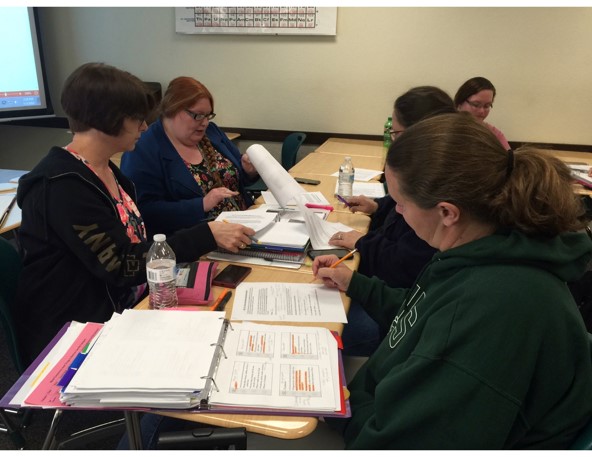
Today’s blog was written by Patricia Pence, Ed.D, MSN, RN, a nursing professor at Illinois Valley Community College.
Pat’s Journey
In October of 2012, after hearing a conference session on active learning, I realized I could no longer teach the same way I had for the past 12 years. I had become a skilled lecturer. Although student feedback on my lecture skills was positive, this seemed to be a passive method to teach what was essential for safe competent nursing care.
Students came to class expecting me to tell them what to write on their printed outline. We’ve probably all experienced a lecture where students come to class unprepared, sit by the wall or in the back of class so they can sleep after working the night before (hoping that you do not notice), interrupt lecture to ask you to repeat what you said, or bring a buffet of food to eat in class, or those students who seem compelled to have side discussions while you are talking.
Often I would hear that some students reviewed maybe 20 minutes before an exam. It became clear to me that as the lecturer I was bearing the responsibility for their learning and putting more time and effort into the class than they were.
If I were responsible for their learning, how would I know whether students really understood the course content after I lectured? Most importantly, how would I know whether they were able to connect content from my lecture to the clinical site where they needed to provide safe nursing care?
In my lecture classes, exams were the prime tool to assess their learning. During clinicals, instructors expected students to independently make sense of all this content conveyed in my PowerPoint slide-after-slide presentation and the text readings, and then apply this “knowledge” to perform nursing skills and make decisions during patient care.
Despite my best lecture skills, I experienced situations in clinical where students were not prepared and not able to make the connections during patient care. How could I better prepare my students to connect learning from the classroom to the clinical site?
A Better Way
One key point taken home from the 2012 conference that I attended was that active learning might be the missing ingredient during my face-to-face class time with my students. I began researching how to “pilot” and implement active learning in my second-semester medical-surgical nursing course that was scheduled in about five months.
My usual lecture content was pre-recorded as podcasts and made available in my Blackboard course. I explained to students how an active learning model would be a benefit to their learning. Students were given handouts on assignments to complete in class. So you would think that all is well and active learning would take place…
Student Resistance
Wrong, my first few attempts at bringing active learning in class did not seem to work so well for my students, or myself.
After all I was introducing a new model for learning that they had not experienced in their previous courses.
A few students made their case before my Dean, “Can she go back to lectures?” My confidence in trying a new teaching model was challenged.
During class, one student suggested Keith’s case studies. Her friend’s instructor in another nursing program used Keith’s case studies and students “loved them”.
Start with Case Studies
This led to contacting Keith to learn more about how to implement his case studies into my course. Keith was extremely encouraging and so supportive of this “newbie” of active learning.
In the next class I asked students to complete one of his case studies in small groups, and then discussed their findings as a whole-class activity. Students were actively engaged and applying content to care for “our patient for the day”.
The picture for today’s blog is an example of these small groups of students collaborating together.
Instead of standing in front of class lecturing, I was able to circulate among the small groups to offer assistance and learn about what my students were thinking before the exam. These were things that normally would not occur in my lecture class.
Although this was early in my teaching efforts at using an active learning model, I could see that the classroom was beginning to be transformed into a “clinical site”. I felt more satisfied in my teaching practice that the burden of who was responsible for learning was slowly being transferred to my students. Students were now learning how to take responsibility for their own learning.
Published Article!
Since then, my first two years of piloting active learning was published in the April 2016 issue of Teaching and Learning in Nursing Journal. I also transformed a first semester fundamentals course into an active learning model, or what I call a “flipped classroom”.
Because students were now introduced to flipping earlier in the nursing program, I had to think of ways to help them take “baby steps” to become comfortable with an active learning model.
KeithRN case studies continue to be a “staple” item in my toolkit of active learning strategies. Per Keith’s high recommendations, I read Dr. Patricia Benner’s book, Educating nurses: A call for radical transformation”, and this book has become my Bible for guiding my teaching practice.
Next Steps
Over time, I have gained the confidence to think of various ways to bring meaningful and relevant real-life learning activities into my classroom, such as stimulating class discussion of nursing care and priorities after showing YouTube videos of physicians performing procedures on real-life patients. “So how will you prepare this patient?” “What are the risks and potential complications?” “What will you be looking for then?”
By now my first-year nursing students know that this is the way I teach.
They come to class better prepared and ready “to apply” what they learned, and help each other.
You might see students demonstrate how to solve medication calculations, or explain how they help a family member with one of the diseases or problems we are learning about.
Students know that if they have a question, I will ask, “where can you find that answer?” So they open their textbook, or look in their notes from my podcasts, or search on their i-phone for the answer to report back to me and the rest of the class.
We all learn from each other. Learning is both student-centered and patient-centered.
My Classroom Today
My classroom does not look and feel the same. You will not see me standing in front of my class with students facing me sitting in desks all lined in rows waiting for me to convey my words of wisdom to write down in their notes.
Students now move their desks into small groups. Mobile devices are routinely accessed. You hear students, even my quiet ones, working together to care for our “virtual patients”.
My classroom helps them to imagine caring for patients, collaborate, and work as teams, similar to if they were working on the hospital or nursing home unit.
In Closing
I want to thank Pat for taking the time to share her journey. If she can do it, you can too!
If you have questions please take the time to contact her or better yet, come to OADN and see her personally!
Though change is difficult for both students and nurse educators, it can and needs to be done. Remember the sub title of Educating Nurses…A Call for RADICAL TRANSFORMATION!
This is more than a “flipped classroom”, but a new way to more effectively teach a practice based profession by contextualizing content, bringing clinical realities to class and emphasizing clinical reasoning.
You are NOT alone! That is the reason I created my website and now over 25 topics of 4 different levels of clinical reasoning case studies that can be literal “tools of transformation!”.
I want to encourage every nurse educator to get a vision of what a transformed classroom could be and take that first step to see it realized!
What do you think?
What have you done to bring active transformational learning to your program?
Comment below and let the conversation begin!
Guest Blogger
 Patricia Pence, Ed.D, MSN, RN has been a nursing professor the past 16 years at Illinois Valley Community College in Oglesby, Illinois.
Patricia Pence, Ed.D, MSN, RN has been a nursing professor the past 16 years at Illinois Valley Community College in Oglesby, Illinois.
She was awarded the Innovations in Teaching Award in 2004 and was the recipient of the Faculty Excellence in Teaching Award in 2016 at Illinois Valley Community College. She enjoys serving as a reviewer for Nurse Educator and Teaching and Learning in Nursing Journal.
If you would like to get in touch with Dr. Pence contact her by email at: pat_pence@ivcc.edu
If you are a nurse educator and would like to share your innovative strategies or tools that have strengthened student learning in your program, contact Keith at: Keith@keithRN.com
References
- Benner, P., Sutphen, M., Leonard, V., & Day, L. (2010). Educating nurses: A call for radical transformation. Stanford, CA: Jossey-Bass.
- Pence, P. L. (2016). “Flipping a first-year medical-surgical associate degree registered nursing course: A 2-year pilot study. Teaching and Learning in Nursing Journal, 11, 52-57.
Keith Rischer – PhD, RN, CEN
As a nurse with over 35 years of experience who remained in practice as an educator, I’ve witnessed the gap between how nursing is taught and how it is practiced, and I decided to do something about it! Read more…
The Ultimate Solution to Develop Clinical Judgment Skills
KeithRN’s Think Like a Nurse Membership
Access exclusive active learning resources for faculty and students, including KeithRN Case Studies, making it your go-to resource.



